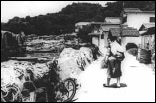|
|
 |
Production Company: Film Kobo Staff: Kakesu Shuichi, Katori Naotaka, Sato Makoto, Shiraki Yoshihiro, Sugita Kazuo, Higuchi Shiro 1983 / B&W, Color / 16mm / 81 min |
| Minamata, 1982. The film begins in color, with a simple explanation of the pollution of the Shiranui Sea by organic mercury from Chisso Corporation's Minamata factory. After a reexamination of the present water pollution situation, the cameras turn to a single family on tiny Yokoura Island. The film then switches to black and white, and the images of the Shiranui Sea which appear will undoubtedly remind many of Tsuchimoto Noriaki's Minamata series. In 1978 the Iwamoto family finally applied for recognition as victims of Minamata disease. The family members include: Yoshimoto Momoe who lives in Yudo and who has considered suicide many times; Ogata, the son of the leader of the fishing village Mejima; and Kozaki, the leader's daughter who raises her son Tatsuzumi, who was himself affected by mercury poisoning whilst still in the womb. Tatsuzumi has grown up since he appeared in Tsuchimoto's first film in the series, Minamata: The Victims and Their World, ("Minamata: kanjasan to sono sekai," 1971). He confesses to us that his condition continues to get worse. After the other Tsuchimoto films, the young film crew of The Innocent Sea was rather reticent to delve once more into the daily lives of those suffering from the disease. However, the faces of children grown to young adulthood against the back ground of small boats fishing in the Shiranui Sea returns one forcefully to the threshold of the Tsuchimoto film. One member of the film crew, Sato Makoto went on to work on Living on the River Agano ("Aga ni ikiru," 1992), a film about the effects of industrial development on the people living by the Agano River in Niigata. |